2015 MERCEDES-BENZ SLS AMG GT ROADSTER tires
[x] Cancel search: tiresPage 237 of 290
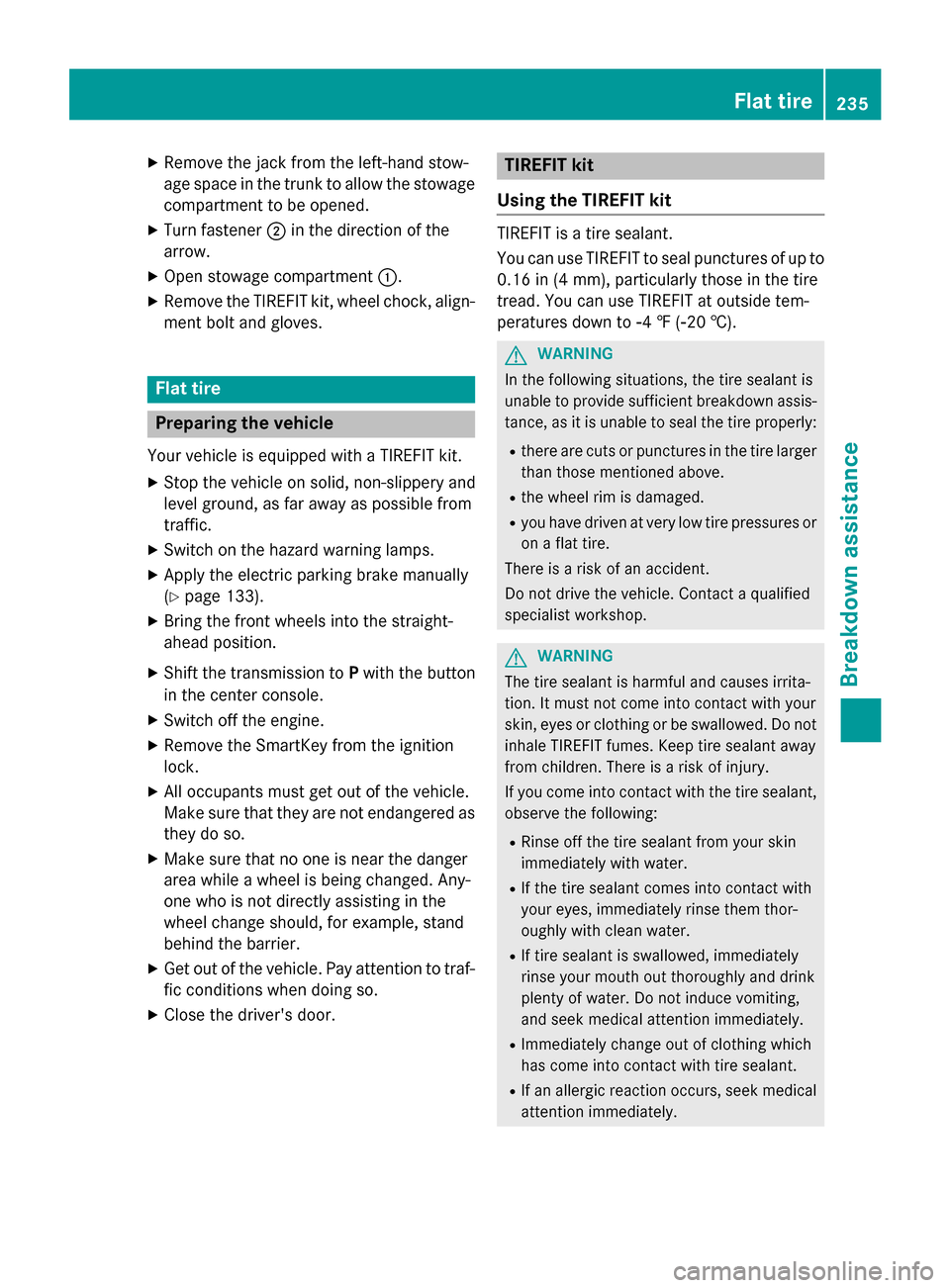
X
Remove th ejackf romt heleft-han dstow-
age spac einthetrunk to allow th estowage
compartmen ttobeopened.
X Turn fastener 0044in th edirection of the
arrow.
X Ope nstowage compartment 0043.
X Remove th eTIREFI Tkit,w hee lchock ,align-
men tbolt and gloves. Flat tire
Preparing th
evehicle
Your vehicl eisequipped wit haTIREFI Tkit.
X Stop th evehicl eons olid, non-slipper yand
level ground ,asfar away as possibl efrom
traffic.
X Switc hont hehazard warnin glamps.
X Apply th eelectric parkin gbrak em anually
(Y page 133).
X Brin gthe fron twheels into th estraight-
ahead position.
X Shift th etransmission to Pwit hthe button
in th ecenter console.
X Switc hoff th eengine.
X Remove th eSmartKey from th eignition
lock.
X Allo ccupant smustg et out of th evehicle.
Mak esuret hatthe ya re no tend angered as
they do so.
X Mak esuret hatnoo neis near th edanger
area while awhee lisb eingchanged. Any-
on ew ho is no tdirectl yassistin ginthe
whee lcha ng es hould, for example, stand
behind th ebarrier.
X Get out of th evehicle. Pay attention to traf-
fic condition swhen doin gso.
X Clos ethe driver's door. TIREFIT kit
Usin gthe TIREFIT kit TIREFI
Tisat ires ealant.
You can use TIREFI Ttoseal punctures of up to
0.16 in (4 mm), particularly those in th etire
tread. You can use TIREFI Tatoutside tem-
peratures down to 00F84‡(00F820 †). G
WARNING
In th efollowin gsituations, th etires ealant is
unable to provid esufficien tbreakdown assis-
tance ,asitisu nable to seal th etirep roperly:
R there are cut sorpunctures in th etirel arger
than those mentioned above.
R thew hee lrim is damaged.
R you hav edriven at ver ylow tire pressures or
on aflat tire.
There is ariskofana ccident.
Do no tdrive th evehicle. Contac taqualified
specialist workshop. G
WARNING
The tire sealant is harmful and causes irrita-
tion .Itm ustn otcome into contact wit hyour
skin ,eyes or clothin gorbeswallowed .Donot
inhale TIREFI Tfumes. Kee ptires ealant away
from children .There is ariskofi njury.
If you come into contact wit hthe tire sealant,
observ ethe following:
R Rinse off th etires ealant from your skin
immediately wit hwater.
R If th etires ealant comes into contact with
your eyes ,immediately rinse them thor-
oughly wit hclean water.
R If tire sealant is swallowed ,immediately
rinse your mout hout thoroughl yand drink
plenty of water. Do no tind ucev omiting,
and see kmedica lattention immediately.
R Immediately chang eout of clothin gwhich
has come into contact wit htires ealant.
R If an allergic reaction occurs, see kmedical
attention immediately. Flat ti
re
235Breakdo wn assis tance Z
Page 238 of 290
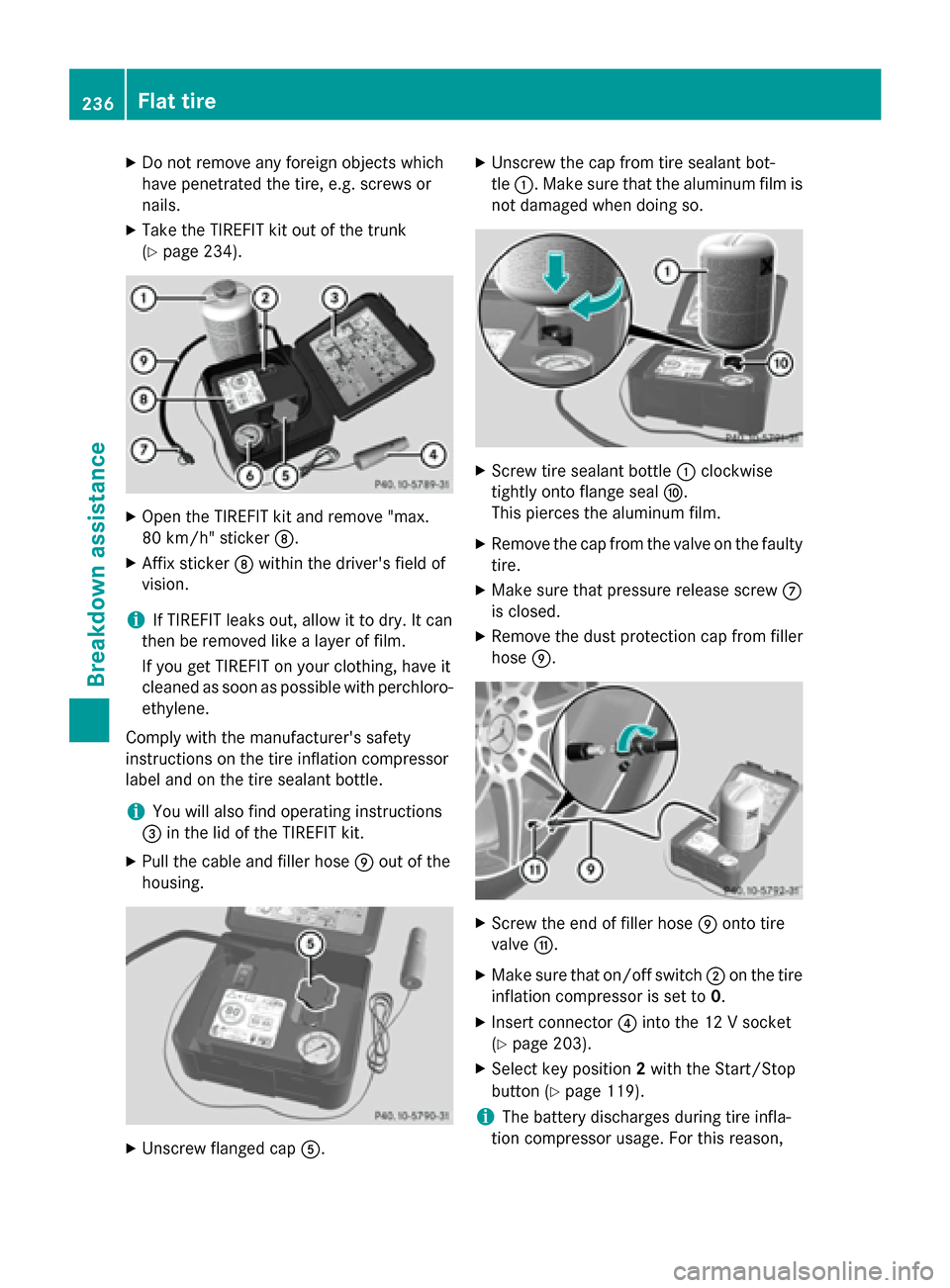
X
Do not remove any foreign objects which
have penetrated the tire, e.g .screws or
nails.
X Take the TIREFIT kit ou tofthe trunk
(Y page 234). X
Open the TIREFIT kit and remove "max.
80 km/h" sticker 006C.
X Affi xsticker 006Cwithi nthe driver's field of
vision.
i If TIREFIT leaks out, allo
wittodry.Itc an
the nberemove dlikeal ayer of film.
If yo ugetTIREFIT on your clothing, have it
cleane dassoona spossibl ewithp erchloro-
ethylene.
Compl ywitht he manufacturer's safety
instructions on the tir einflatio ncompressor
labe land on the tir esealan tbottle.
i Yo
uw illa lsof indo perating instructions
0087 in the li dofthe TIREFIT kit.
X Pull the cable and fille rhose 006Doutoft he
housing. X
Unscrew flange dcap 0083. X
Unscrew the cap fro mtires ealan tbot-
tle 0043.M akes uret hatthe aluminu mfilmis
not damage dwhend oing so. X
Scre wtires ealan tbottle 0043 clockwise
tightl yonto flange seal 006E.
This pierces the aluminu mfilm.
X Remov ethe cap fro mthe valv eonthe faulty
tire.
X Make sure tha tpressure release screw 006B
is closed.
X Remov ethe dust protection cap fro mfiller
hose 006D. X
Scre wthe end of fille rhose 006Donto tire
valve 006F.
X Make sure tha ton/off switch 0044on the tire
inflatio ncompressor is se tto0.
X Insert connector 0085into the 12 Vsocket
(Y page 203).
X Select key position 2with the Start/Stop
button (Y page 119).
i Th
eb attery discharge sdurin gtirei nfla-
tio nc ompressor usage. For thi sreason, 236
Flat tireBreakdow
nassistance
Page 239 of 290
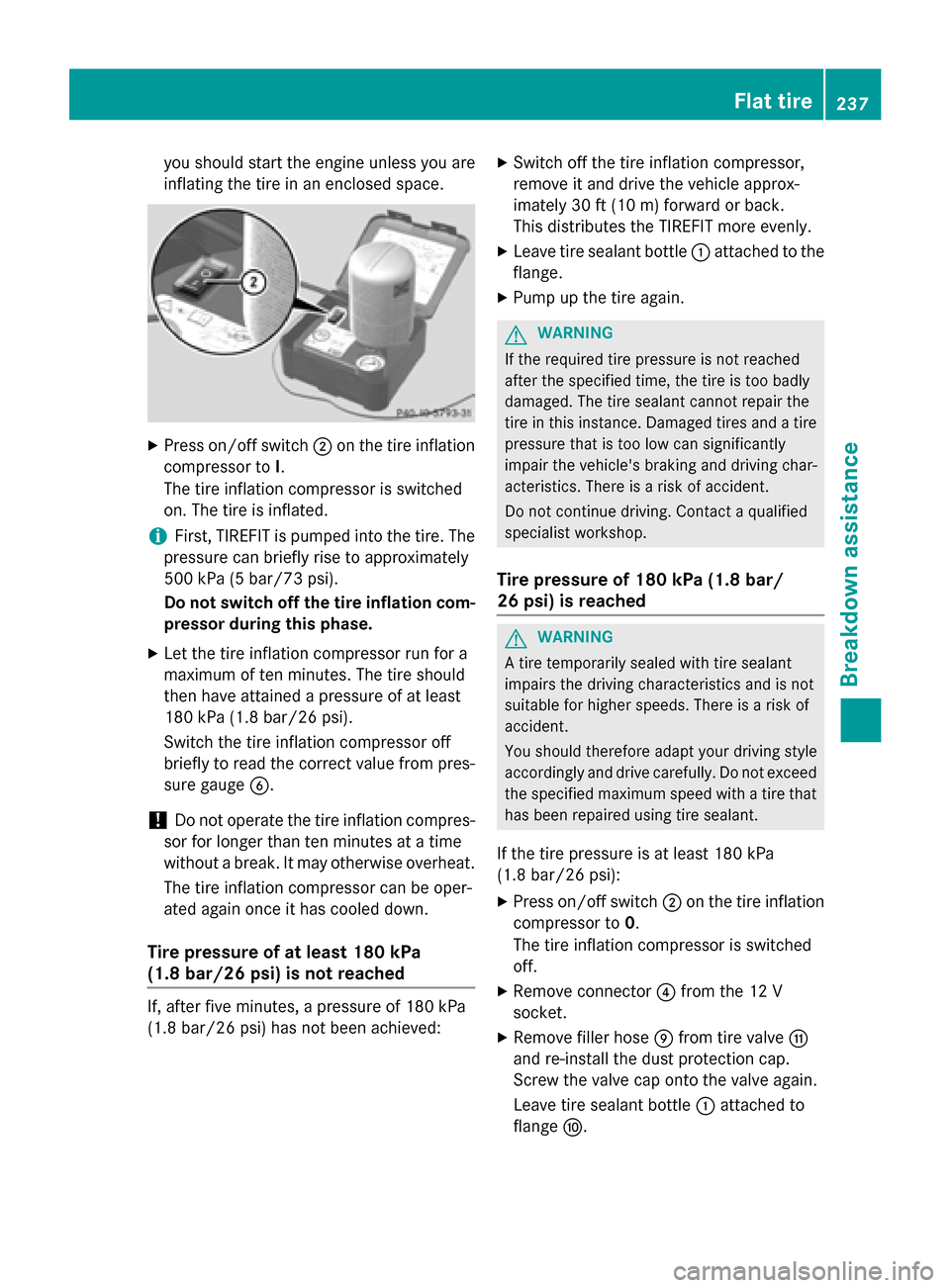
you should start th
eengineu nless you are
inflatin gthe tire in an enclosed space. X
Press on/off switch 0044on th etirei nflation
compressor to I.
The tire inflation compressor is switched
on .The tire is inflated.
i First
,TIREFI Tisp umped into th etire. The
pressur ecan briefl yrisetoa pproximately
50 0k Pa(5 bar/73 psi).
Do not switch off th etirei nflation com-
pressor during this phase.
X Let th etirei nflation compressor run fo ra
maximum of te nminutes. The tire should
then hav eattained apressur eofatl east
18 0k Pa (1.8 ba r/26psi).
Switch the tire inflation compressor off
briefly to read the correct value from pres- sure gauge 0084.
! Do not operate the tire inflation compres-
sor for longe rthan ten minute satatime
without abreak. It may otherwise overheat.
The tire inflation compressor can be oper-
ated again once it has coole ddown.
Tire pressure of at leas t180 kPa
(1.8 bar/2 6psi) is not reached If, after five minutes,
apressure of 180 kPa
(1.8 bar/26 psi )has not bee nachieved: X
Switch off the tire inflation compressor,
remove it and drive the vehicle approx-
imately 30 ft (10 m) forward or back.
Thi sd istributes the TIREFIT more evenly.
X Leave tire sealant bottle 0043attache dtothe
flange.
X Pump up the tire again. G
WARNING
If the required tire pressure is not reached
after the specified time, the tire is too badly
damaged. The tire sealant cannot repair the
tire in this instance. Damaged tires and atire
pressure that is too low can significantly
impair the vehicle's braking and driving char-
acteristics. There is arisk of accident.
Do not continue driving. Contact aqualified
specialist workshop.
Tire pressure of 180 kPa (1.8 bar/
26 psi) is reached G
WARNING
At ire temporarily sealed with tire sealant
impairs the driving characteristics and is not
suitabl efor higher speeds. There is arisk of
accident.
You should therefore adapt you rdriving style
accordingl yand drive carefully .Donot exceed
the specified maximu mspee dwithatire that
has bee nrepaired using tire sealant.
If the tire pressure is at least 180 kPa
(1.8 bar/26 psi): X Press on/off switch 0044on the tire inflation
compressor to 0.
The tire inflation compressor is switched
off.
X Remove connector 0085from the 12 V
socket.
X Remove filler hose 006Dfrom tire valve 006F
and re-instal lthe dus tprotectio ncap.
Screw the valve cap onto the valve again.
Leave tire sealant bottle 0043attache dto
flange 006E. Flat tire
237Breakdow nassistance Z
Page 251 of 290

Useful information
............................250
Importan tsafet ynotes .................... 250
Operation ........................................... 250
Winter operation ............................... 252
Tir ep ressure ..................................... 253
Loading the vehicle ..........................260
All about wheels and tires ...............263
Changing awheel ............................. 270
Wheel and tir ecombinations ...........275 249Wheels and tires
Page 252 of 290

Useful information
i This Operator's Manual describes all
models and all standard and optional equip- ment of your vehicle available at the time of
publication of the Operator's Manual.
Country-specific differences are possible.
Please not ethat your vehicle may not be
equipped with all feature sdescribed. This
also applies to safety-related system sand
functions.
i Please read the information on qualified
specialist workshops (Y page 23).Important safet
ynotes G
WARNING
If wheels and tires of the wrong size are used, the wheel brakes or suspensio ncomponents
may be damaged. There is arisk of an acci-
dent.
Always replace wheels and tires with those
that fulfill the specification softhe original
part.
When replacin gwheels, make sure to use the
correct:
R designation
R model
When replacin gtires ,make sure to use the
correct:
R designation
R manufacturer
R model G
Warning
Af lat tire severely impairs the driving, steer-
ing and brakin gcharacteristic softhe vehicle.
There is arisk of an accident.
do not drive with aflat tire. Immediately
replace the flat tire with your spare wheel, or
consult aqualified specialist workshop.
Accessories that are not approved for your
vehicle by Mercedes-Benz or that are not being used correctly can impair the operating
safety.
Before purchasin gand using non-approved
accessories, visit aqualified specialist work-
shop and inquire about:
R suitability
R legal stipulations
R factory recommendations
Information on dimensions and types of
wheels and tires for your vehicle can be found (Y page 275).
Information on air pressure for the tires on
your vehicle can be found:
R on the vehicle' sTire and Loading Informa-
tion placard on the B-pillar
R on the tire pressure label on the fuel filler
flap
R under "Tire pressure"
i Further information on wheels and tires
can be obtained at any qualified specialist
workshop. Operation
Information on driving
R If the vehicle is heavily loaded, chec kthe
tire pressures and correct them if neces-
sary.
R While driving, pay attention to vibrations,
noises and unusual handling characteris-
tics, e.g. pulling to one side. This may indi- cate that the wheels or tires are damaged.If you suspect that atire is defective,
reduce your speed immediately. Stop the
vehicle as soon as possible to chec kthe
wheels and tires for damage. Hidden tire
damage could also be causing the unusual
handling characteristics. If you find no
signs of damage, have the wheels and tires checked at aqualified specialist workshop.
R When parkin gyour vehicle, make sure that
the tires do not get deformed by the curb or
other obstacles. If it is necessary to drive
over curbs, speed humps or similar eleva- 250
OperationWheels and tires
Page 253 of 290

tions, try to do so slowly and at an obtuse
angle .Otherwise, the tires ,particularl ythe
sidewalls, ma ybedamaged. Note
sonh ighp erformanc etires G
WARNING
Due to the special tir etrea dinc ombination
with the optimize drubbe rcompound ,there is
an increase driskofh ydroplaning and skid-
ding on adam porw etroa dsurface. tir egripis
also noticeabl yreduced at lo woutside tem-
peratures and lo wtireo perating tempera-
tures .The re is ariskofana ccident.
Turn on ESP ®
and adap tyou rd riving style
accordingly .Whent he outside temperature
fall sbelow 10 †, us eM+S tires.
i Different driving style
smaylead to high
tir ew eara nd the tires ma yreach the min-
imum tir etrea ddepth after onl yashort
time. Regula
rcheckin gofwheelsand tires G
WARNING
Damaged tires can cause tir einflatio npres-
sure loss. As aresult, yo ucould lose control of
your vehicle. There is ariskofa ccident.
Check the tires regularly for signs of damage
and replace any damage dtires immediately.
Regularl ycheck the wheels and tires of your
vehicl efor damage at leas tonce amonth ,as
well as after driving off-roa doronrough
roads .Damaged wheels can cause alossof
tir ep ressure. Pa yparticula rattentio ntodam-
ag es ucha s:
R cuts in the tires
R punctures
R tears in the tires
R bulges on tires
R deformatio norseverec orrosio nonwheels Regularl
ycheck the tir etrea ddepth and the
condition of the trea dacros sthe whol ewidth
of the tir e(Ypage 251). If necessary ,tur nt he
front wheels to full lock in order to inspect the
inne rsideoft he tir esurface.
All wheels must have avalve cap to protect
the valv eagain st dirt and moisture. Do not
mount anything onto the valv eother tha nthe
standard valv ecap or other valv ecaps
approved by Mercedes-Benz for your vehicle.
Do not us eany other valv ecapsors ystems,
e.g .tirep ressure monitoring systems.
Regularl ycheck the pressure of al lthe tires
particularl yprior to long trips .Adjust the tire
pressure as necessary (Y page 253).
Th es ervice life of tires depends on the fol-
lowing factors amongst other things:
R driving style
R tirep ressure
R distance covered Tire tread
G
WARNING
Insufficient tir etrea dw illr educ etiret raction.
Th et ireisnol ongera bletod issipate water.
This means tha tonwetroa dsurfaces ,the risk
of hydroplaning increases, in particula rwhere
spee disn ot adapted to suit the driving con-
ditions. There is ariskofa ccident.
If the tir epressure is too high or too low, tires
ma yexhibit different level sofwearatd iffer-
ent locations on the tir etread. Thus ,you
shoul dregularly check the trea ddepth and
the condition of the trea dacros sthe entire
width of al ltires.
Minimum tir etrea ddepth for:
R Summer tires: 00CEin (3 mm)
R M+S tires: 00CFin (4 mm)
For safety reasons, replace the tires before
the legall yprescribe dlimit for the minimum
tir et rea ddepth is reached. Operation
251Wheelsand tires Z
Page 254 of 290
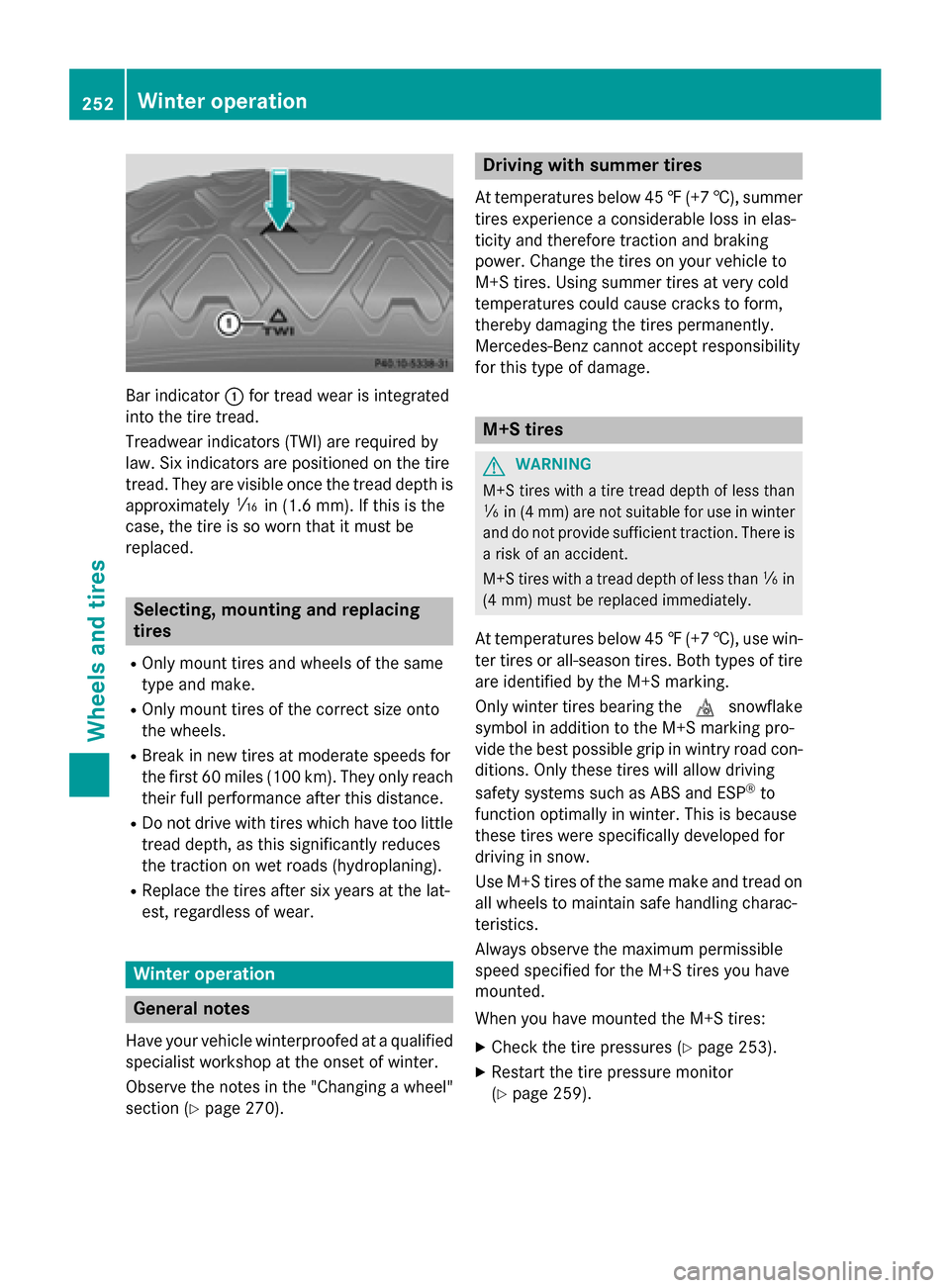
Bar indicator
0043for trea dwearisi ntegrated
into the tire tread.
Treadwear indicator s(TWI) are required by
law. Six indicator sare positioned on the tire
tread. The yare visible once the trea ddepth is
approximately 00CDin (1.6 mm). If this is the
case ,the tire is so worn that it mus tbe
replaced. Selecting, mounting and replacing
tires
R Only mount tire sand wheel softhe same
typ eand make.
R Only mount tire softhe correct size onto
the wheels.
R Brea kinn ew tire satmoderate speeds for
the firs t60miles (100 km) .The yo nly reach
thei rfullp erformance afte rthis distance.
R Do not drive with tire swhich have too little
trea ddepth, as this significantl yreduces
the traction on we troads (hydroplaning).
R Replace the tire saftersix years at the lat-
est, regardless of wear. Winter operation
General notes
Have your vehicle winterproofe dataqualified
specialist worksho patthe onse tofwinter.
Observe the notes in the "Changing awheel"
section (Y page 270). Drivin
gwiths ummer tires
At temperatures below 45 ‡(+7† ), summer
tires experience aconsiderable loss in elas-
ticity and therefore traction and braking
power. Change the tires on you rvehicle to
M+S tires. Using summe rtires at very cold
temperatures coul dcause cracks to form,
thereb ydamaging the tires permanently.
Mercedes-Benz cannot accep tresponsibility
for this type of damage. M+S tires
G
WARNING
M+S tires with atire tread depth of less than
00CF in (4 mm )are not suitabl efor use in winter
and do not provide sufficient traction. There is
ar isk of an accident.
M+S tires with atread depth of less than 00CFin
(4 mm) must be replaced immediately.
At temperatures below 45 ‡(+7† ), use win-
ter tires or all-season tires. Both type softire
are identified by the M+S marking.
Only winter tires bearing the 004Dsnowflake
symbol in addition to the M+S marking pro-
vide the best possibl egrip in wintry road con-
ditions. Only these tires will allow driving
safety systems such as ABS and ESP ®
to
function optimally in winter. Thi sisbecause
these tires were specifically developed for
driving in snow.
Use M+S tires of the same make and tread on
allw heels to maintain safe handling charac-
teristics.
Always observe the maximu mpermissible
spee dspecified for the M+S tires you have
mounted.
When you have mounted the M+S tires:
X Check the tire pressure s(Ypag e253).
X Restart the tire pressure monitor
(Y pag e259). 252
Winte
roperationWheels and tires
Page 255 of 290
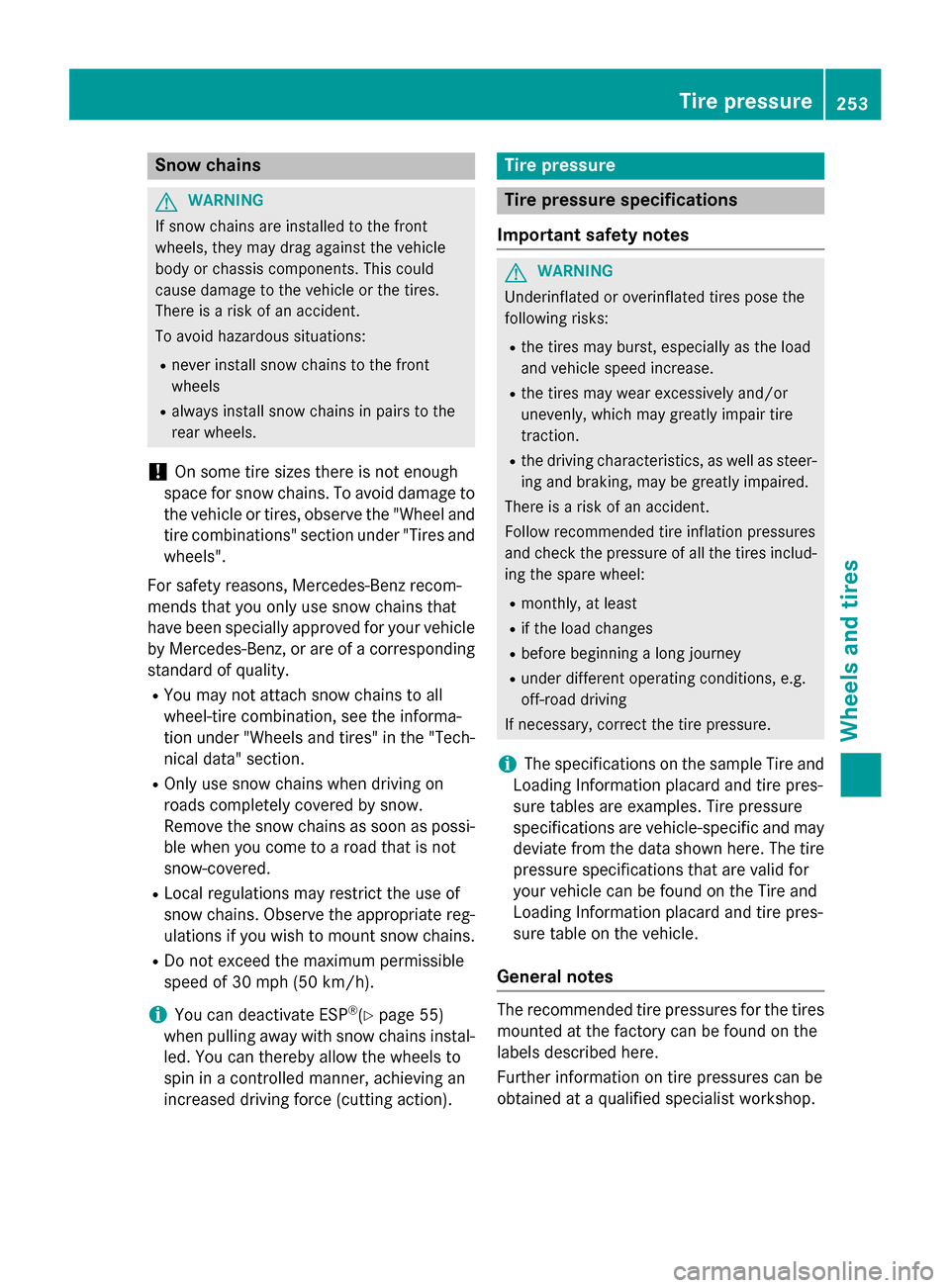
Snow chains
G
WARNING
If snow chains are installed to the front
wheels, they may drag against the vehicle
body or chassis components. This could
cause damage to the vehicle or the tires.
There is arisk of an accident.
To avoid hazardous situations:
R never install snow chains to the front
wheels
R always install snow chains in pairs to the
rear wheels.
! On some tire sizes there is not enough
space for snow chains. To avoid damage to
the vehicle or tires, observe the "Wheel and tire combinations" section under "Tires and
wheels".
For safety reasons, Mercedes-Benz recom-
mends that you only use snow chains that
have been specially approved for your vehicle by Mercedes-Benz, or are of acorresponding
standard of quality.
R You may not attach snow chains to all
wheel-tire combination ,see the informa-
tion under "Wheels and tires" in the "Tech-
nical data" section.
R Only use snow chains when driving on
roads completely covered by snow.
Remove the snow chains as soon as possi- ble when you come to aroad that is not
snow-covered.
R Local regulations may restrictt he use of
snow chains. Observe the appropriate reg- ulations if you wish to mount snow chains.
R Do not exceed the maximum permissible
speed of 30 mph (50 km/h).
i You can deactivate ESP ®
(Y page 55)
when pulling away with snow chains instal-
led. You can thereby allow the wheels to
spin in acontrolled manner, achieving an
increased driving force (cuttinga ction). Tire pressure
Tire pressures
pecifications
Important safety notes G
WARNING
Underinflated or overinflated tires pose the
following risks:
R the tires may burst, especially as the load
and vehicle speed increase.
R the tires may wear excessively and/or
unevenly, which may greatly impair tire
traction.
R the driving characteristics, as well as steer-
ing and braking, may be greatly impaired.
There is arisk of an accident.
Follow recommended tire inflation pressures
and check the pressure of all the tires includ-
ing the spare wheel:
R monthly, at least
R if the load changes
R before beginning along journey
R under different operating conditions, e.g.
off-road driving
If necessary, correct the tire pressure.
i The specifications on the sample Tire and
Loading Information placard and tire pres-
sure tables are examples. Tire pressure
specifications are vehicle-specific and may
deviate from the data shown here. The tire pressure specifications that are valid for
your vehicle can be found on the Tire and
Loading Information placard and tire pres-
sure table on the vehicle.
General notes The recommended tire pressures for the tires
mounted at the factory can be found on the
labels described here.
Further information on tire pressures can be
obtained at aqualified specialist workshop. Tire pressure
253Wheels and tires Z